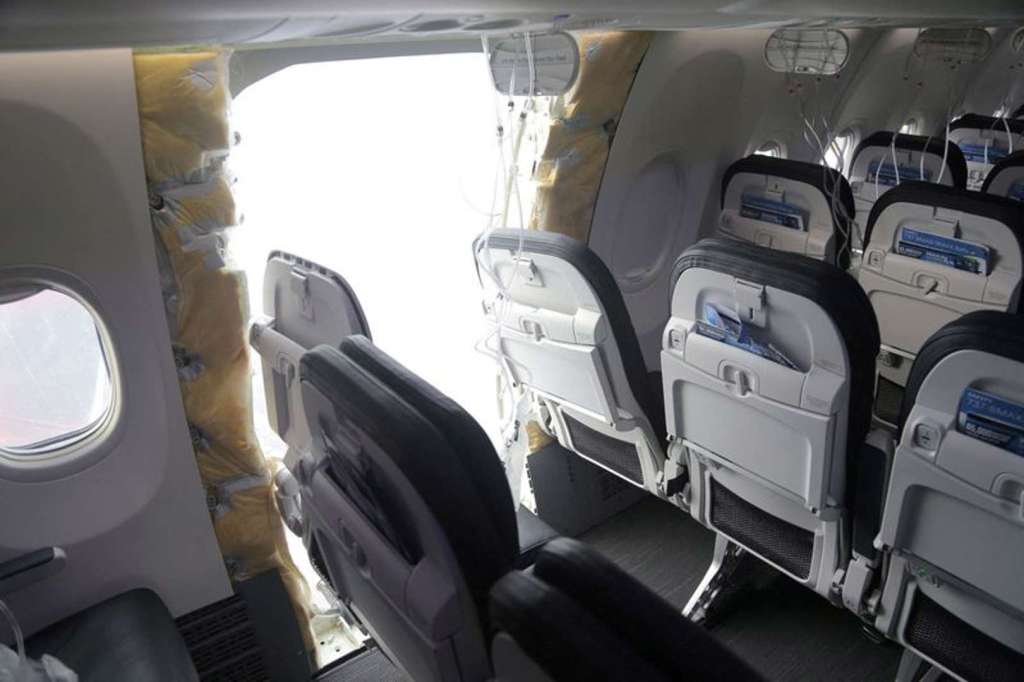2024 began with incidents involving aircraft doors in North America. On 07 January 2024, the door plug from an Alaskan Airlines Boeing 737 Max came off about 10 minutes after it took off from Portland International Airport. The aircraft was at about 16,000 feet when the incident occurred. After about 20 minutes, the aircraft made an emergency landing at Portland Airport safely.
The door plugs are inserted where emergency exit doors would be located. The plug is secured in place by bolts that prevent the mechanism from moving upward on rollers when the plane is in flight.
The blowout created a partial vacuum inside the aircraft that twisted the metal of the seats nearby, and snatched cellphones, headsets and even the shirt off the teenager’s back. Luckily, the two seats closest to the blown-out hole were unoccupied.
The Fasten Seat-belt sign was on at the time of the incident and the seat-belt saved the teenager. The pilot generally keeps the sign on until reaching cruising altitude. Different airlines have different policies on turning off the sign – some until reaching cruising altitude, some at 18,000 feet and some at 10,000 feet – if the pilots feel it safe.
The oxygen masks dropped immediately, and the flight attendants moved passengers from the area where the blowout occurred. The roaring wind was so loud that passengers could hardly hear the captain’s announcements.
The pilot immediately descended to 10,000 feet, where there is enough oxygen for everyone onboard to breathe. If the blowout had happened a few minutes later, after the plane reached cruising altitude, the accident might have become a tragedy.
A passenger on an Air Canada flight from London, UK, to Toronto allegedly tried to open the aircraft doors mid-flight on 21 January 2024. He had to be restrained by the crew as part of their flight and safety protocols, which allowed for the flight to continue normally to Toronto.
Police entered the aircraft once the plane landed and found the passenger, an elderly man, in a state of crisis and confusion. The Police said, “It does not appear that his actions were intentional.” The Police did not lay any criminal charges.
Is it possible to open the doors of an aircraft mid-flight?
It is not possible to open aircraft doors at high altitude as the doors are designed to act as a plug that takes advantage of the differences in internal and external air pressure to create a secure seal. Try opening the pressure cooker at home when it is under pressure!!!
“Cabin crew – arm doors and cross check” – You will hear this from the cockpit, over the aircraft’s Public Address System at the start of every flight as the aircraft starts to push back from the gate. It means that the door is ready for use in an emergency evacuation. Once armed, if the door is opened, the escape slide or raft will deploy and inflate – in less than six seconds.
An aircraft is pushed back from the gate by a tractor to avoid the need for reverse thrust from the engines. Reverse thrust requires high engine power and creates a high-speed jet blast. This blast can distribute debris that can cause injuries to ground crew and may damage airport terminals, aero-bridges, and ground vehicles.
After landing, you will hear the pilot ask the crew to “Cabin Crew – disarm all doors,” (there is no Check Back here) meaning that the emergency slide has been deactivated.
On 08 January 2024, a passenger with Air Canada was injured after he opened the cabin door and fell out of the plane onto Toronto Airport’s tarmac on a flight to Dubai, resulting in a six-hour delay. The man boarded the aircraft, but instead of going to his seat, opened the cabin door at the opposite end of the plane and jumped on to the tarmac. He sustained minor injuries and was attended to by the emergency services. As per Police, the man was in a state of crisis when the incident occurred and suffered relatively minor injuries. He was apprehended by police and transported to a local hospital for treatment.
Confrontations on flights have increased since the pandemic started, with some altercations captured and replayed on social media.
Passengers do become anxious with the onset usually prior to boarding and continues throughout the flight, with more reports of anxiety on longer flights. In one unusual case, a man complained of physical ill-health, which resulted in diversion of the plane for his hospitalisation. He was diagnosed with ‘Jet-set Munchausen Syndrome.’
Munchausen’s syndrome is named after a German aristocrat, Baron Munchausen, who became famous for telling wild, unbelievable tales about his exploits and past. Munchausen Syndrome is when someone tries to get attention and sympathy by falsifying, inducing, and/or exaggerating an illness. They lie about symptoms, manipulate medical tests, or harm themselves. Diagnosing and treating Munchausen syndrome is difficult because of the patient’s dishonesty. In simple military terms – it is Shamming.
As per a study by Miller, Warren & Zarcone, Vincent. (1968), Psychiatric Behavior Disorders at an International Airport – suicidal ideation – may occur during flight in people who are mentally unwell. On rare occasions, the aircraft itself is used as the means of suicide.
Lester, D (2002) in an article Suicide and Aircraft Crisis in The Journal of Crisis Intervention and Suicide Prevention, describes two instances of commercial aircraft crashing because of a suicidal passenger killing the pilot and co-pilot, resulting in the death of all the passengers. In each case the perpetrator had purchased life insurance, presumably to benefit his family. Disappearance of Malaysia Airlines Flight MH370 on 08 March 2014 will arise in the reader’s mind.
Another psychotic behaviour is Airport Wandering. In certain psychotic patients whose conflicts relate to separation and reunion demonstrate a causal relationship between airport settings and ideas relating to abandonment and reuniting with family. They may be found wandering in various airports around the world.
Although the frequency of psychiatric emergencies is much lower than that of other medical emergencies in-flight, the public is likely to be less tolerant of such incidents. Control of disturbed behaviour in an aircraft poses much greater potential hazards than on the ground. Seriously dangerous incidents in the air are fortunately statistically rare but have a high public impact.
In future, Will there be a need to prove psychological stability prior to boarding an aircraft? Or Will the airlines screen the passengers for psychological stability?





